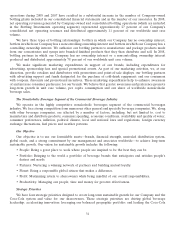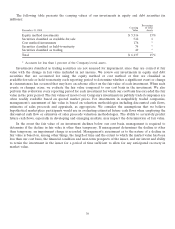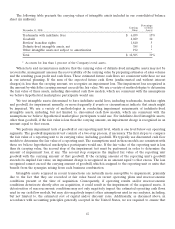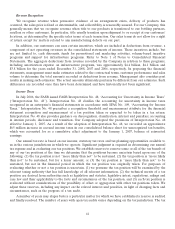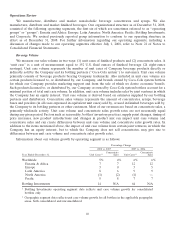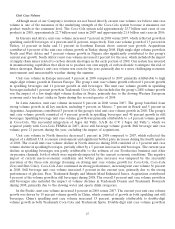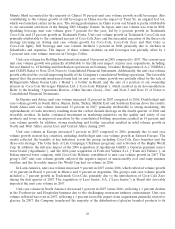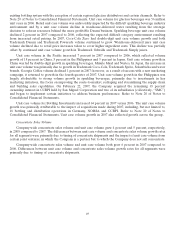Coca Cola 2008 Annual Report Download - page 46
Download and view the complete annual report
Please find page 46 of the 2008 Coca Cola annual report below. You can navigate through the pages in the report by either clicking on the pages listed below, or by using the keyword search tool below to find specific information within the annual report.Revenue Recognition
We recognize revenue when persuasive evidence of an arrangement exists, delivery of products has
occurred, the sales price is fixed or determinable, and collectibility is reasonably assured. For our Company, this
generally means that we recognize revenue when title to our products is transferred to our bottling partners,
resellers or other customers. In particular, title usually transfers upon shipment to or receipt at our customers’
locations, as determined by the specific sales terms of each transaction. Our sales terms do not allow for a right
of return except for matters related to any manufacturing defects on our part.
In addition, our customers can earn certain incentives, which are included in deductions from revenue, a
component of net operating revenues in the consolidated statements of income. These incentives include, but
are not limited to, cash discounts, funds for promotional and marketing activities, volume-based incentive
programs and support for infrastructure programs. Refer to Note 1 of Notes to Consolidated Financial
Statements. The aggregate deductions from revenue recorded by the Company in relation to these programs,
including amortization expense on infrastructure programs, was approximately $4.4 billion, $4.1 billion and
$3.8 billion for the years ended December 31, 2008, 2007 and 2006, respectively. In preparing the financial
statements, management must make estimates related to the contractual terms, customer performance and sales
volume to determine the total amounts recorded as deductions from revenue. Management also considers past
results in making such estimates. The actual amounts ultimately paid may be different from our estimates. Such
differences are recorded once they have been determined and have historically not been significant.
Income Taxes
In July 2006, the FASB issued FASB Interpretation No. 48, ‘‘Accounting for Uncertainty in Income Taxes’’
(‘‘Interpretation No. 48’’). Interpretation No. 48 clarifies the accounting for uncertainty in income taxes
recognized in an enterprise’s financial statements in accordance with SFAS No. 109, ‘‘Accounting for Income
Taxes.’’ Interpretation No. 48 prescribes a recognition threshold and measurement attribute for the financial
statement recognition and measurement of a tax position taken or expected to be taken in a tax return.
Interpretation No. 48 also provides guidance on derecognition, classification, interest and penalties, accounting
in interim periods, disclosure and transition. Our Company adopted the provisions of Interpretation No. 48
effective January 1, 2007. As a result of the adoption of Interpretation No. 48, we recorded an approximate
$65 million increase in accrued income taxes in our consolidated balance sheet for unrecognized tax benefits,
which was accounted for as a cumulative effect adjustment to the January 1, 2007, balance of reinvested
earnings.
Our annual tax rate is based on our income, statutory tax rates and tax planning opportunities available to
us in the various jurisdictions in which we operate. Significant judgment is required in determining our annual
tax expense and in evaluating our tax positions. We establish reserves to remove some or all of the tax benefit of
any of our tax positions at the time we determine that the positions become uncertain based upon one of the
following: (1) the tax position is not ‘‘more likely than not’’ to be sustained, (2) the tax position is ‘‘more likely
than not’’ to be sustained, but for a lesser amount, or (3) the tax position is ‘‘more likely than not’’ to be
sustained, but not in the financial period in which the tax position was originally taken. For purposes of
evaluating whether or not a tax position is uncertain, (1) we presume the tax position will be examined by the
relevant taxing authority that has full knowledge of all relevant information, (2) the technical merits of a tax
position are derived from authorities such as legislation and statutes, legislative intent, regulations, rulings and
case law and their applicability to the facts and circumstances of the tax position, and (3) each tax position is
evaluated without considerations of the possibility of offset or aggregation with other tax positions taken. We
adjust these reserves, including any impact on the related interest and penalties, in light of changing facts and
circumstances, such as the progress of a tax audit.
A number of years may elapse before a particular matter for which we have established a reserve is audited
and finally resolved. The number of years with open tax audits varies depending on the tax jurisdiction. The tax
44


